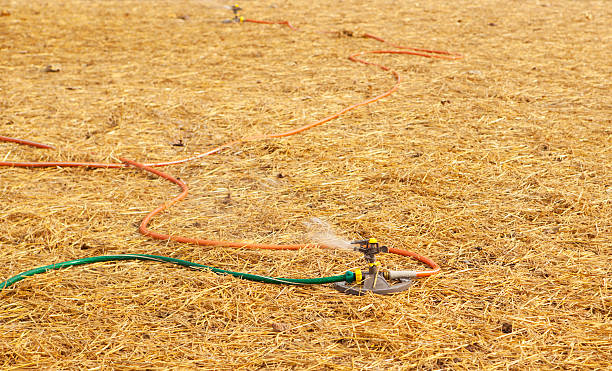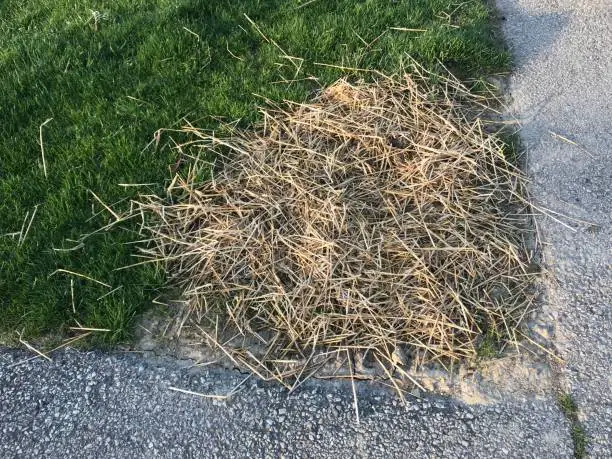Newly seeded lawn? Then you already know that in addition to that thorough initial watering, the next most important thing is ensuring that you keep the seed in place until it’s able to germinate and develop its own root system in your yard. Of course, proper seed spread, moisture, and sunlight are crucial to germination as well, but if the seed isn’t able to make contact with the ground soil that it’s placed on, it’s likely not going to grow very well.
That’s where covering grass seeds with straw can come in handy. In this post, we’ll discuss more about this cover grass seed option, the pros and cons of placing it on newly seeded lawns, how to apply it, and more. Here’s a closer look at what you need to know about using straw for lawn grass seed germination.
Benefits of Straw for Grass Seed
Let’s begin with some of the benefits of placing aged pine straw over new grass seeds.
Moisture
Placing straw over new grass seeds helps to lock in moisture, which means you don’t need to water as much to encourage grass seed germination. It’s important that new seeds are always moist.
Prevents seed movement
As we noted in the beginning, you don’t want the wind to blow seeds away or for soil erosion to occur based on weather conditions. Aged pine straw will help lock seeds in place until grass seed germinates, encouraging better universal growth and preventing any patchy areas in a new lawn.
Discourages bird activity
Birds and other small animals might see unprotected seeds as an easy meal. Straw can help protect new grass seedlings from these critters.
Easy to apply, clean up
Straw is fairly easy to apply and clean up. In fact, some types of straw don’t even need to be removed after grass seed germination. Some straws will simply decompose into the soil after a period of time, adding nutrients and organic matter to the soil.

Downfalls to Straw
Despite its benefits, it’s important to also be aware of some of the potential disadvantages of using straw as well. Here’s a look:
May not be seed free
While straw is generally free of any weed seeds, it may contain thistle and grain seeds, which can be problematic for a new lawn.
It’s a bit messy
Straw isn’t the most aesthetically pleasing lawn layer to look at and it can be a bit messy to apply when placing. It’s also likely to break away from the lawn during high winds.
It can damage new grass during removal
Newly germinated seeds have young roots that need to continue to be nurtured. When raking up or removing straw following grass seed germination, there is a chance of new grass damage if you don’t do it right. Be sure the grass seedlings are established and strong enough to withstand the straw removal.
It’s not fool-proof
Apply straw too thick and grass seeds won’t grow. We’ll get into how to properly apply a layer of straw over a new lawn in the next section.
Does Grass Seed Grow if Not Covered?
Grass seeds can germinate and grow if not covered as long the grass seed is kept moist. However, covering the grass seed with a thin layer of straw mulch, topsoil, or compost will help retain moisture and speed up the germination process.
Application – How To Apply Straw
- Prep the soil and place the seeds: You’ll want to agitate the soil that you’re sowing seeds on, then place the seeds per manufacturer recommendations.
- Place the straw: One bale of straw should cover about 1,000 square feet. Place the straw so that the soil is visible through the layer. Don’t place it too thick or it won’t be able to get the sunlight and moisture it needs.
- Water it in: Give the lawn a thorough initial watering after the straw has been placed.
- Remove: Remove straw following grass seed germination, usually after the seeds are tall enough for an initial mowing. If the straw doesn’t need to be removed, allow it to compost and add nutrients to the soil.

How Much Straw Is Needed For New Grass?
Straw is typically sold by the bale or bagged and sold in smaller amounts. Straw sold by the bale will cover up to 1,000 square feet of lawn, while that sold in bags typically covers up to 500 square feet.
How Long to Leave Straw on New Grass?
Don’t remove the straw from the grass until the seeds have germinated and your new lawn is ready for that first mowing.
How do you remove the straw? It’s important to do this very gently and use a pitchfork rather than a rake. While using a pitchfork, attempt to lift the straw up rather than rake it away.
Peat Moss or Straw for Grass Seed?
There are a few alternatives to using straw for grass seeds to encourage seed germination. One is peat moss, and unlike straw, this helps aerate the soil to encourage oxygen flow.
Alternative To Straw For Grass Seed
In addition to peat moss, some other straw alternatives for covering grass seed include:
- Pennington Slopemaster
- Mulch or compost: The nutrients help encourage grass seed growth while working to protect seeds from heat, wind and more
- Sawdust: An inexpensive straw substitute
- Starter fertilizer: This helps accelerate germination
Peat moss is probably the most common alternative to straw for grass seed cover, but can be particularly messy to work with. The best way to apply peat moss is to use a peat moss roller like the Landzie. This catches any larger chunks of peat moss and mulch, and makes for a smooth even coverage.
Weed Control and New Lawns
Because certain herbicides will prevent any new seeds from germinating and cannot be applied to new lawns, weeds are always a threat to a new lawn. Here’s how you can control weeds from the start:
- Seed in the fall: Weed growth isn’t as common in the fall as in the spring and summer.
- Apply Tenacity: This seed-safe product helps encourage healthy lawn growth while preventing the emergence of weeds.
- Apply pre-emergent herbicide in the spring: Next spring when the seeding is more well aged, apply a pre-emergent herbicide to snuff out weeds before they have a chance to grow.
More Straw Grass Seed FAQs
What to do with straw after the grass grows?
In some cases, you don’t have to do anything and it will merely decompose into your newly seeded lawn. In other cases, it’s necessary to remove the thin straw layer. You can also use it as compost, mulch or as animal bedding.
Will grass seed grow through straw?
Yes, if it’s a thin layer of straw, grass seedlings should have sprouted through it after germination.
What is better to grow grass, straw or hay?
Straw is preferred for a newly seeded lawn, as it has a lower overall seed content.

Can I use pine needles to cover the newly seeded area? The needles will also have chaf etc. from the floor of the pine grove.
Hi Tim. I’ve never tried pine needles. I would suspect as long as they’ve completely fired out and have no sap they could possibly be used – though challenging to remove once there is new grass growth. Fresh needles can do quite a bit of damage to the lawn beneath.
Nice article! I am planting seed on bare ground this week. Can I use straw thru the winter or would it be better to top the bare ground with the black weed fabric. I worry that the straw will blow away whereas I can attach the fabric to the ground. Thanks!
Thanks, Bill. You might want to remove the straw before winter – especially after the grass has germinated and will likely need to be mowed.
Great. I was thinking of watering before placing straw, I see I place the straw first over new seed on tilled soil.